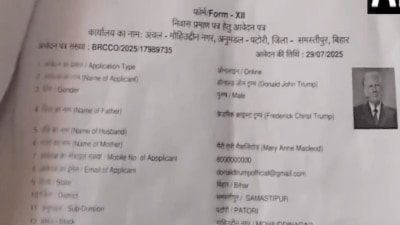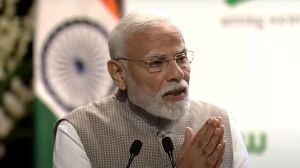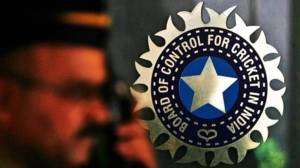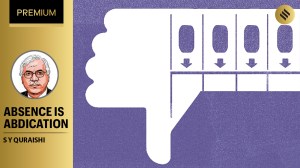Unified pension scheme worse than NPS: AAP
Although the AAP government in Punjab had already notified implementation of old pension scheme (OPS) on November 18, 2022, they are yet to implement it in letter and spirit.
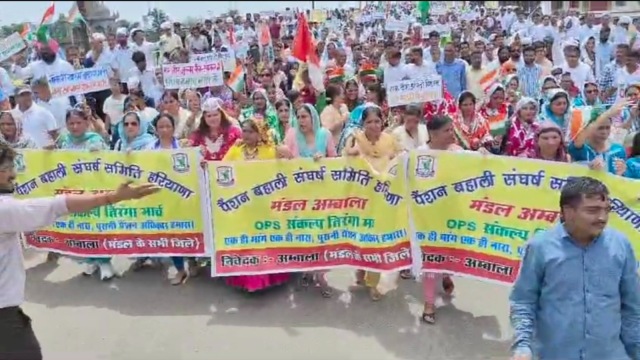 A protest rally was organised by Purani Pension Bahali Sangrash Samiti of Haryana at Ambala on Sunday. (Express Photo)
A protest rally was organised by Purani Pension Bahali Sangrash Samiti of Haryana at Ambala on Sunday. (Express Photo)A day after the NDA regime at the Centre approved the unified pension scheme (UPS) for central government employees aimed at providing financial security to them post-retirement, the AAP on Sunday described it “worse than new pension scheme (NPS)”.
The first reaction from a senior spokesperson for the AAP, Neel Garg, was, “It is worse than new pension scheme (NPS). The employees will keep on contributing their 10% of the basic pay for the entire service period and at the end, they will not pay back the lump sum amount deducted but will calculate pension on the basis of the last-drawn basic salary which is 50% of the average basic pay of the last working year.”
Although the AAP government in Punjab had already notified implementation of old pension scheme (OPS) on November 18, 2022, they are yet to implement it in letter and spirit.
Talking about it, Garg said, “Yes, the AAP government has already notified implementation of OPS and we are keen to implement it. But the Centre is not giving us the corpus amount (of the employees) deducted under NPS from January 1, 2004, onwards. The rolling out of UPS shows the pressure the NDA government is feeling ahead of of the elections in Haryana, Jammu and Kashmir. Jharkhand, Maharashtra, and Delhi will also go to polls in the coming months.”
Though Ludhiana MP and Punjab Pradesh Congress Committee president Amrinder Singh Raja Warring couldn’t be reached for his comments on UPS, Congress national president Mallikarjun Kharge wrote on X, “The ‘U’ in UPS stands for Modi Govt’s U turns! Post June 4, the power of the people has prevailed over the arrogance of power of the Prime Minister.” For the record, NPS was implemented by the Atal Bihari Vajpayee-led NDA government on January 1, 2004.
From May 2004 till May 2014, the Congress-led UPA government was in power at the Centre, and NPS continued during that tenure as well.
What employees say
The employees’ unions of Punjab have already stated that only OPS can give financial security to the employees in their old age.
Jasveer Talwara, state convener of the Old Pension Restoration Struggle Committee, said, “Employees have been continuously protesting against NPS since 2004 and have been demanding to replace it with OPS. As a result of this ongoing struggle, the government now appears to be in a tight corner on two key issues: the restoration of OPS and the Agniveer issue. Under pressure from the protests, the central government on August 24 decided to replace NPS with UPS. However, the standard operating procedure (SOP) for this has not yet been issued.”
 Protest rally by Purani Pension Bahali Sangrash Samiti of Haryana at Ambala. (Express photo)
Protest rally by Purani Pension Bahali Sangrash Samiti of Haryana at Ambala. (Express photo)
He added, “Implementation of UPS is nothing more than an amendment to the NPS which is not in the interest of employees but benefits corporates. It is nothing but deception. The Old Pension Restoration Struggle Committee rejects it outright.”
Jarnail Singh Patti, secretary of the committee, said, “According to the information available so far, under UPS employees who have completed 25 years of service will receive a pension amounting to 50% of their average basic pay over the last 12 months prior to retirement. The minimum pension amount will be Rs 10,000 per month, with a provision for dearness relief (DR).
The lump sum amount to be received upon retirement will be calculated based on gratuity, which will be reduced by multiplying one-tenth of the last-drawn salary, including DA, by the number of completed six-monthly periods of service. This amount will be given as lump sum, whereas under NPS employees were entitled to 60% of the total corpus as lump sum. This reduction seems to benefit corporates directly.”
 Protest rally by Purani Pension Bahali Sangrash Samiti of Haryana at Ambala. (Indian express)
Protest rally by Purani Pension Bahali Sangrash Samiti of Haryana at Ambala. (Indian express)
“The government’s contribution to UPS will increase to 18.5% which was 14% in NPS. This is also just a gimmick. What benefit does an employee get from an increased matching share if the lump sum amount to be paid back on retirement is not increasing? This too seems to be a ploy that benefits the corporate sector,” said Talwara.
The Old Pension Restoration Struggle Committee of Punjab remains firm in its demand for restoration of OPS, said the members. At present, there are over 2 lakh employees in Punjab under NPS in more than 50 government departments.
Devinder Sharma, an agriculture expert, said, “If employees can get an assured monthly pension, why shouldn’t farmers get a legally guaranteed minimum support price (MSP) for crops? If market-linked pension doesn’t work for employees, why do we think market-linked farm prices work for farmers? Farmers too need assured prices.”
For the record, under OPS, government employees used to get defined benefits post retirement – 50% of their last-drawn salary as monthly pension.
Under NPS, which covers employees who joined service post January 2004, contributions are defined but benefits depend on the market.
UPS has included features of an assured pension from OPS as well as defined contributions from NPS. UPS has features similar to OPS in the form of an assured pension, inflation indexation, family pension and minimum pension.
UPS has included the feature of contributory, fully funded scheme from NPS.


